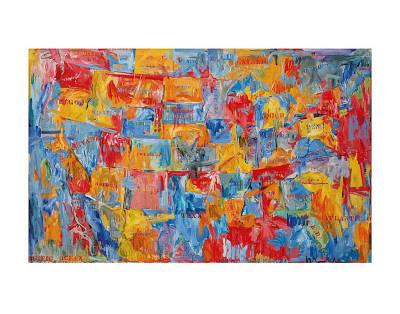

Johns’s muteness about his work is a refusal to take responsibility for how it affects us. Dealing with them is like being conducted to a certain place and looking back to discover that your guide has vanished.

The meanings of Johns’s art are pantomimes of meaning: cerebral hooks baited with visual seduction. Attempts to make sense of the disjuncture and of what it may entail or suggest fill library shelves of exegetic prose. © Siah Armajani, courtesy MAMCO, GenevaĮver since his first painting of the American flag, begun in 1954, Johns has mastered a trick of replicating schematic motifs with an expressive hand that feels indifferent to what it describes. “Dictionary for Building: Street to Roof,” by Siah Armajani. You may find yourself in a state of doing neither, your neuronal toggle stuck, buzzing, between the two functions. The wiring of eyesight in your brain won’t let you do both at once. You can seek to make out the figure or contemplate how Johns painted it. As always, his beautiful touch-as patient as solitaire, as unpredictable as roulette-simultaneously establishes and etherealizes the image. Burrows did not.) Perhaps cued by Farley’s camouflage uniform, Johns renders the scene to, or beyond, the limit of legibility, in various mediums, chiefly puddled ink and watercolor on plastic. His name and that of the intrusive photojournalist appear on some works in the series, in Johns’s familiar stencilled, paint-thick lettering: in the fullest versions, “ Farley Breaks Down-after Larry Burrows.” (Lance Corporal James Farley survived the war.

© Jasper Johns / VAGA at ARS, courtesy Matthew Marks Galleryįace in hands, the stricken soldier contorts in agony, evidently weeping and plainly oblivious of being observed, alone in an equipment shed. I’m not so sure about the dozen or so paintings and drawings derived from a photograph that was published in Life, in 1965, of a young Marine helicopter gunner in Vietnam after a disastrous mission during which a crewmate was killed. Most sport flat, Buster Keaton-ish hats: comical but not funny. There are more than two dozen small vertical pictures of individual, standing skeletons or bodies with their bones revealed, presenting themselves like visitors in doorways. In the present show, they run to death and sorrow, with a fillip of political history. Johns is a riddler, even-or especially-when his themes are blatant. This rankles, because what he makes seems positively to pant for discussion. He doesn’t-will not, don’t waste your breath asking him-discuss his works. Many of the writers, who now include Alexi Worth, a contributor to the catalogue of a show of recent work by Johns at the Matthew Marks Gallery, remark with some ratio of awe and exasperation on the artist’s taciturnity. Critical verbiage spumes in the wake of a sixty-some-year career (Johns is eighty-eight) that began with revolutionary paintings of flags, targets, sets of numbers, and maps-or, per a standard paradox, paintings that virtually are those things. In the 1970s he produced paintings composed of clusters of parallel lines that he called "crosshatchings" in the 1980s he experimented with figuration.More words may have been written about Jasper Johns than about any other American artist who isn’t Andy Warhol. From 1961 he began to attach real objects to his canvases. Johns's unabashed depiction of commonplace emblems and objects was emulated by many Pop art artists. In their willful and ironic banality and their rejection of emotional expression, these early works were a radical departure from the then-dominant Abstract Expressionist style. He was able to raise these objects to the level of icons through his paint handling and manipulation of surface texture, which he obtained through the encaustic technique. The paintings Johns went on to produce depict commonplace, two-dimensional subjects such as flags, targets, maps, numbers, and letters of the alphabet. In 1958 he had his first one-man exhibition, a rousing success. He began his career as a commercial artist, producing displays for New York City shop windows. Image is Copyrighted and Property of its respective ownerĪbout the ArtistJasper Johns (born May 15, 1930, Augusta, Ga., U.S.) is an American painter, sculptor, and printmaker.


 0 kommentar(er)
0 kommentar(er)
